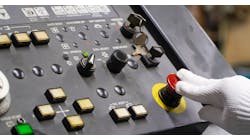Robert Brooks Editor-in-Chief [email protected]
Strolling around a recent equipment expo, asking the customary questions of equipment builders and supplier companies about the state of their businesses and the conditions in the machining industry, there were some encouraging reports. Many shops are thriving on medical equipment business, or aerospace and defense projects, and this is good for the machine builders, the tooling suppliers, the automation and software developers, etc. Most surprising to me was the enthusiasm conveyed by some equipment suppliers about increasing activity among manufacturers of firearms. That certainly deserves some deeper analysis.
For now, though, let’s look at those other manufacturers and suppliers whose reply to the standard inquiry is a grimace or a shrug: “You know how it is,” they’d relate in one manner or another. Ten months into an admittedly severe recession, they’ve lowered their expectations for much, if any, progress. They’re lack of enthusiasm says everything.
It’s fine to be hopeful about some market hot spots, or to identify positive indicators in interest rates or currency exchanges, but those signals define the business climate we are in now. They do nothing to direct us to where we need to be.
What the downcast exhibitors, and all of us, really need is some initiative. We need to locate new products, or applications, or capabilities that will break through buyer anxiety or indifference. We need to redefine how consumers view the market we represent, and to raise their expectations for themselves and their own potential. We need to make them want to buy goods and services.
Just as important, we need to see some new potential for ourselves and for the enterprises where we do our work. We need to find reasons to look forward.
But, if the impulse is to look backward, try this: 10 years ago the world was in the first throes of Internet mania. Anything with an “e-” in front of its name could earn venture capital. Every business was scrambling to establish a Web site, and every home and office was wiring up for Web access — and soon afterward for better, faster Web access.
Of course, that 90’s boom fizzled. It got too hot too fast and money was blown. But, it revived, too. No one ever claimed free markets were perfectly stable. In fact, until very recently, it was the dynamism of free markets that most of us seemed to appreciate so well.
More to the point, that 90’s era economic expansion wasn’t entirely — nor even mostly — based on Web-based ventures. It started well before the Web went mainstream, and it continued up to last fall. It thrived on the emergence of automation and network technology, wireless systems and devices, and an astounding diversity of new products and equipment that multiplied the number of consumers of goods and services worldwide.
It was driven by demand — by a widespread eagerness for things that are new, different, and better, and by the competition (i.e. the performance demanded from us) to make that happen.
All of this is a reminder that the consumer, the customer, is the one that defines a growing, expanding market. Today, customers aren’t buying much of anything, and our economy is being defined by restraint, not demand. The emphasis is on conserving, maintaining, and saving. That may calm some nerves, but it won’t fire any imaginations. It won’t spur much expansion or drive growth.
Today’s problems are an inversion of the 90’s fizzle — everything got too cold too fast. There’s a world of consumers demanding to be fired up. From our managers and leaders we should demand the freedom and resources to meet that demand. From ourselves we should demand the creativity and confidence to make it happen.






